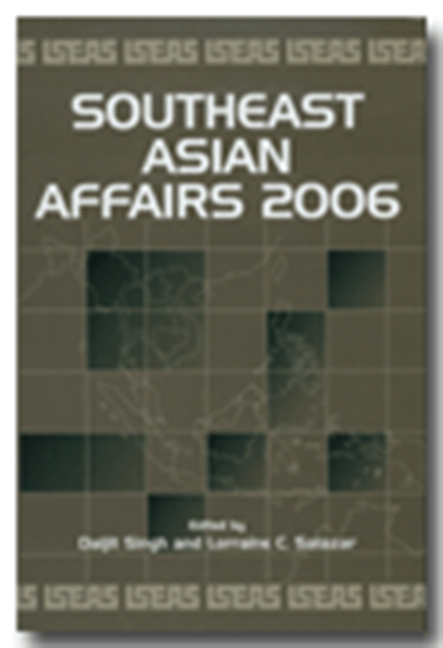Book contents
- Frontmatter
- Contents
- Foreword
- Introduction
- The Region
- Southeast Asia in 2005: Strength in the Face of Adversity
- Southeast Asian Economies: A Year of Exogenous Shocks
- Terrorism: Evolving Regional Alliances and State Failure in Mindanao
- Japan in an Insecure East Asia: Redefining Its Role in East Asian Community-Building
- Brunei darussalam
- Cambodia
- Indonesia
- Laos
- Malaysia
- Myanmar
- The Philippines
- Singapore
- Thailand
- Timor Leste
- Vietnam
Southeast Asian Economies: A Year of Exogenous Shocks
from The Region
Published online by Cambridge University Press: 21 October 2015
- Frontmatter
- Contents
- Foreword
- Introduction
- The Region
- Southeast Asia in 2005: Strength in the Face of Adversity
- Southeast Asian Economies: A Year of Exogenous Shocks
- Terrorism: Evolving Regional Alliances and State Failure in Mindanao
- Japan in an Insecure East Asia: Redefining Its Role in East Asian Community-Building
- Brunei darussalam
- Cambodia
- Indonesia
- Laos
- Malaysia
- Myanmar
- The Philippines
- Singapore
- Thailand
- Timor Leste
- Vietnam
Summary
The year 2005 will likely be remembered by most Southeast Asian countries as the year of negative exogenous shocks. Exogenous shocks to the economy often receive less analysis in textbooks than they deserve. Nevertheless, such shocks can have significant and long-term economic effects, as the oil shocks in 1970s did. The most important of these shocks in 2005 was the tsunami that occurred on 26 December 2004 and claimed more than 100,000 lives across several countries. The slowdown in the global economy and the rise in oil prices further weakened growth in Southeast Asia during 2005.
This article begins with an analysis of overall economic growth in the region in 2005. It is followed by a more detailed analysis of the macroeconomic performance of Southeast Asian economies. Towards the end of the article the impact of the tsunami as well as the risk of a pandemic avian flu is discussed.
overall Growth
The global economy went into a moderate cyclical slowdown in 2005 due to a number of factors — rising US interest rates, lower US and euro area growth, the rise in oil prices, and the catastrophic effects of Hurricane Katrina. Compared with the world's growth rate of 5.1 per cent in 2004, a record high in the last three decades, the global economy grew at a rate of 4.3 per cent in 2005. While the slowdown affected both developed and developing countries, growth in the developing world continued to be strong, at 5.9 per cent. This growth rate was twice as fast as that estimated for developed countries. Growth in the Asia-Pacific region, at 6 per cent, was expected to be higher than growth in the developing world as a whole. This was partly due to vigorous exports and strong domestic demand in China and India.
Southeast Asian economies grew at an estimated average rate of 5 per cent in 2005. This was lower than the economic growth rate of 6.3 per cent in the previous year.
- Type
- Chapter
- Information
- Southeast Asian Affairs 2006 , pp. 15 - 25Publisher: ISEAS–Yusof Ishak InstitutePrint publication year: 2006

